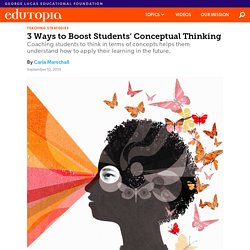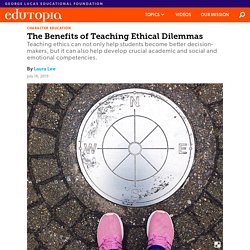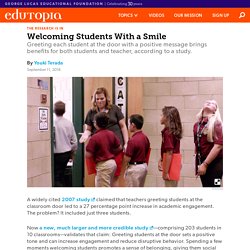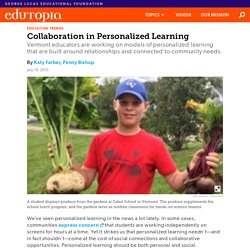

Howard Gardner on Multiple Intelligences. France bans children under 15 from using phones in school. 3 Ways to Boost Students’ Conceptual Thinking. We want our students’ learning to be enduring, enabling them to make sense of complexity now and in the future.

For this to occur, we need to nudge students beyond the learning of facts and skills to uncover concepts—transferable ideas that transcend time, place, and situation. Learning knowledge and skills is like standing in the middle of a forest, surrounded by trees: It’s easy to spot details but hard to see patterns.
For students to think conceptually, they need opportunities to head up to the mountaintop, pause, and take in the entire forest. They need the chance to search for big ideas—to generalize, summarize, and draw conclusions by looking at their learning in a holistic way. By intentionally designing learning activities in which students move between the factual and conceptual levels of thinking, we can help them construct understanding, facilitate transfer, and build their sense of agency.
Edutopia. How Learning Happens. How can schools better align their practices with what the science says about human learning?

Our new video series, featuring Linda Darling-Hammond, president and CEO of Learning Policy Institute, and Pamela Cantor, MD, founder and senior science advisor of Turnaround for Children, pairs research insights with a variety of illustrative strategies from schools, all grounded in the science of human learning and development. We think these techniques will resonate with educators everywhere: They are focused on taking advantage of the incredible opportunity to help children reach their full potential by creating positive relationships, experiences, and environments in which every student can thrive. In fact, the science is beginning to hint at even more dramatic outcomes. 6 Scaffolding Strategies to Use With Your Students.
What’s the opposite of scaffolding a lesson? Saying to students, “Read this nine-page science article, write a detailed essay on the topic it explores, and turn it in by Wednesday.” Yikes! No safety net, no parachute—they’re just left to their own devices. Let’s start by agreeing that scaffolding a lesson and differentiating instruction are two different things. Scaffolding is breaking up the learning into chunks and providing a tool, or structure, with each chunk. Assessment. 10 Ways to Improve Transfer of Learning. Whether you’re a student or working professional looking to keep your skills current, the importance of being able to transfer what you learn in one context to an entirely new one cannot be overstated.

Of course, the goal of any learning or training is to eventually be able to apply it in real-world situations, but a PayScale survey released last year found that 60 percent of employers don’t believe recent graduates are well-prepared for their jobs. One possible reason for this is that memory is context dependent, so transferring or recalling something that was learned in a classroom setting to a fast-paced work environment isn’t always easy. Once you understand how to go about transferring your knowledge to new contexts, however, you could change jobs or even careers and still find ways to apply your prior knowledge to the situations and problems you might face in a new role. 1. Focus on the relevance of what you’re learning 2. 3. 4. 5. 6. 7. 8. 9. 10.
About Marianne Stenger. A-level revision tips for top grades – with less stress. Spring brings bluebells, apple blossom and the return of the cuckoo, but for thousands of A-level candidates it’s the season of exam stress and revision.

Students will be putting in long hours to reach their university place offers, so how can they make the best use of their time? Who better to ask than last year’s candidates who got the grades they needed to secure their first choice of university place? Looking back, they agree it’s not the amount of time spent revising that matters but the effort put in. You have to make neuron connections, not massage your brain gently between bursts of social media therapy, they say. Plenty of breaks and the occasional night out helped them to make the most of their hours spent revising.
Take it steady is also the advice from examiners. Total recall of the syllabus and churning out what you know will not necessarily secure the high grades, examiners warn. Revision should be an assault course not a marathon, and past papers can provide the hurdles. The Powerful Effects of Drawing on Learning and Memory. Edutopia. Ethical decision-making is a crucial part of comprehensive education, but few schools teach ethics, writes Linda Flanagan, advisory board member for the The Ethics Institute at Kent Place School, in a recent KQED Mindshift piece.

Introducing ethical dilemmas in the classroom can open up opportunities not only for debate and critical thinking, but also for personal growth, empathy for other viewpoints, and self-reflection. Effective ethics instruction is about more than distributing a list of moral guidelines; it requires teaching students how to navigate their own moral decision-making. Edutopia. How Learning Happens. A Simple but Powerful Class Opening Activity. At the start of a recent class, my students gathered a bouquet of good news: a trip to Ireland, an end to recent car troubles, an upcoming visit with a friend.

These were highlights they shared during our start-of-class routine, the rose and thorn check-in. In this quick activity, students participate by sharing roses—something positive going on for a student that day—and thorns, which are negative, or at least less than positive. Students can choose their level of vulnerability: A rose can simply be “the weather is nice today.” A low-stakes thorn might be “I feel tired.” Yet many students choose to share more personal items: “My rose is that even though I’m stressed out, I got all my homework done” or “My thorn is that my dog is sick and I’m really worried about her.”
Going around the classroom, each student states one rose and one thorn. Benefits of the Check-In Facilitation Tips Tending to Challenges Here are some tips for making this activity go smoothly: Help Your Garden Grow. Welcoming Students With a Smile. A widely cited 2007 study claimed that teachers greeting students at the classroom door led to a 27 percentage point increase in academic engagement.

The problem? It included just three students. Now a new, much larger and more credible study—comprising 203 students in 10 classrooms—validates that claim: Greeting students at the door sets a positive tone and can increase engagement and reduce disruptive behavior. Spending a few moments welcoming students promotes a sense of belonging, giving them social and emotional support that helps them feel invested in their learning. The first few minutes of class are often the most chaotic, as students transition from busy areas such as the hallway or playground. Ten middle school teachers were randomly assigned by the researchers to one of two groups. Teachers in the second group attended classroom management training sessions offered by their schools, but they weren’t given any specific instructions on how to start class. Building Community. Hands-Off Teaching Cultivates Metacognition. As a teacher, you put a lot of thought into how to make your class and the material as accessible and engaging as possible.

You think about what you know, and how you first learned it. You think about what your students already know, and how to use that knowledge as the foundation for what you're about to teach. And, as if that's not enough, you think about how to make your content so engaging that no matter what else is happening (lunch next period, upcoming prom, or the latest social media scandal among the sophomores), your lesson will hold your students' attention. All that thought goes into a lesson, and still there are students spacing out during class or seeming to fall behind. Working so hard and still not reaching every student can be frustrating. Edutopia. We’ve seen personalized learning in the news a lot lately.

In some cases, communities express concern that students are working independently on screens for hours at a time. Yet it strikes us that personalized learning needn’t—and in fact shouldn’t—come at the cost of social connections and collaborative opportunities. 12 Fun Speaking Games for Language Learners. When working with world language classes or English language learners, have you ever asked a question only to be answered with complete silence and blank stares?

It’s a common issue—nearly every teacher has struggled with encouraging students to speak in a language they’re still learning. A student may have a deep fear of making a mistake, or may be just plain shy, even in their native language. 12 Fun Speaking Games for Language Learners. How Learning Happens.